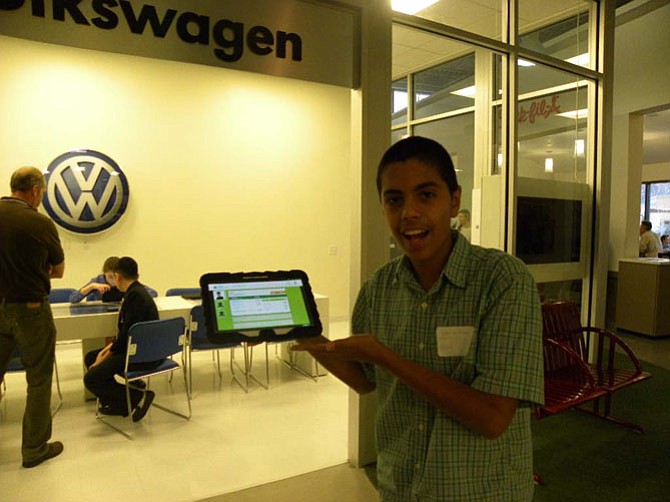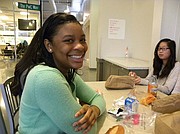A 13-year-old at Kilmer Middle School, Saul’s character is a human resource manager with a 3-year-old child. He plans to budget for entertainment, such as a television because watching television is important to him. Photos by Abigail Constantino/The Connection
That Christmas check from grandma will probably be spent on the latest video game or that trendy pair of boots a typical teenager has been saving to buy. But for eighth graders in Fairfax County, they might think twice before splurging on that one luxury item.
Kilmer Middle School eighth graders put into practice what they have been learning for the past 6 to 8 weeks in their math and civics classes about budget, credit scores, compound interests, and paying bills on Tuesday, Dec. 16 at JA Finance Park in Fairfax, a financial literacy center that looks like a marketplace or a mall.
“I make more than you” and “How much do you make” are not polite things to discuss as adults but they were commonly heard among the eighth graders posing as adults with financial responsibilities for the day. “I want to buy a Mercedes, too,” said one student, whose persona for the day is a 28-year-old male with a wife and one child. His character makes $30,000 a year and has $28,000 in student loans. By the time he creates his budget, he will find that public transportation may be a better choice than a luxury vehicle.
Cailey, 13, is posing as a single mother working as a furniture designer and making $43,000 a year. She has one child. “I never thought about childcare,” she said as she unlocks the item for childcare on her tablet.
THE TABLETS are part of the digitization of the financial literacy curriculum this year. Rachel Wunder, senior director of Finance Park, said that before this year, students used paper to create and balance their budgets. With an infusion of $900,000 from Capital One, one of the park’s partners, and also KPMG, each participant now uses a tablet, which makes the experience more realistic, as people are using more technology tools to navigate their finances and children are more likely to use them when they become adults.
“Behaviors are set by the time you’re in middle school,” said Capital One’s Clifford L. Yee, senior director of community affairs and market president network. He said that financial literacy is crucial in keeping the economy going, and his company wants to make sure that young people are successful.
FCPS social studies coordinator Alice Reilly said that eighth grade is a good time to start incorporating financial literacy. “Some of them are starting to earn money by babysitting,” she said. The Finance Park program is mandatory for all FCPS eighth graders and began in 2006 in mobile trailers in the Capital One offices in Tysons Corner.
With a movement to incorporate financial literacy in education, spurred, in part, by the financial crisis, and increasing enrollment in FCPS, JA Finance park opened in 2010 to accommodate students in Fairfax County and other nearby schools.
Rob Paine, who teaches Civics at Kilmer Middle School, said that the students are receptive to learning about finances in class and the culmination at JA Finance Park is a “tremendous eye-opener.” They have a completely new view of financial literacy after a day and it makes an impression on them, he said.
After researching and creating a budget, each student goes to each storefront to buy what they need with their debit cards loaded with their budget. Stores are sponsored by companies and have the look and feel of the company sponsor’s brand, making the commercial aspect more realistic for the students.
Each student is also required to make a stop at the “That’s Life” kiosk, which throws a monkey wrench into their carefully planned budget, such as a broken car or other unexpected bills.
But the biggest surprise for the children may be the life with which they were dealt. Julien, 13, thought that he would make more than $40,000 at 29, with a wife and one child. Outside of the park, Julien is actually an entrepreneur and started a business selling unique coffee blends. Melena, 13, never thought she would be a single mother with two children. “I didn’t expect to be single,” she said.
HELPING THE STUDENTS navigate their adult responsibilities for a day are volunteers who put things in perspective, which includes quality of life. “Make sure you put in for electricity,” reminded one of the volunteers, “Otherwise, you’re living in the woods.”
Though students may not finish the day as financial experts, they will come out in the black, as one of the requirements is to not go over their budget. Julie Rosenthal of Junior Achievement of Greater Washington said that the students will definitely learn and appreciate what it takes to spend money. “Even if the takeaway is just a ‘Thank you, Mom.’”
JA Finance Park is partnership between the Junior Achievement of Greater Washington--a nonprofit that teaches students financial leadership, entrepreneurship, and workforce readiness--Fairfax County Public Schools, Capital One, and KPMG LLP.


